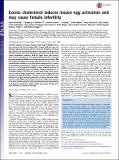| dc.contributor.author | Yesilaltay, Ayce | |
| dc.contributor.author | Dokshin, Gregoriy A. | |
| dc.contributor.author | Busso, Dolores | |
| dc.contributor.author | Wang, Li | |
| dc.contributor.author | Galiani, Dalia | |
| dc.contributor.author | Vasile, Eliza | |
| dc.contributor.author | Quilaqueo, Linda | |
| dc.contributor.author | Orellana, Juan Andrés | |
| dc.contributor.author | Shalgi, Ruth | |
| dc.contributor.author | Dekel, Nava | |
| dc.contributor.author | Albertini, David F. | |
| dc.contributor.author | Rigotti, Attilio | |
| dc.contributor.author | Krieger, Monty | |
| dc.contributor.author | Walzer, Dalia F. | |
| dc.contributor.author | Page, David C | |
| dc.contributor.author | Chavarria, Tony E | |
| dc.date.accessioned | 2015-05-11T14:19:30Z | |
| dc.date.available | 2015-05-11T14:19:30Z | |
| dc.date.issued | 2014-11 | |
| dc.date.submitted | 2013-07 | |
| dc.identifier.issn | 0027-8424 | |
| dc.identifier.issn | 1091-6490 | |
| dc.identifier.uri | http://hdl.handle.net/1721.1/96953 | |
| dc.description.abstract | The HDL receptor scavenger receptor, class B type I (SR-BI) controls the structure and fate of plasma HDL. Female SR-BI KO mice are infertile, apparently because of their abnormal cholesterol-enriched HDL particles. We examined the growth and meiotic progression of SR-BI KO oocytes and found that they underwent normal germinal vesicle breakdown; however, SR-BI KO eggs, which had accumulated excess cholesterol in vivo, spontaneously activated, and they escaped metaphase II (MII) arrest and progressed to pronuclear, MIII, and anaphase/telophase III stages. Eggs from fertile WT mice were activated when loaded in vitro with excess cholesterol by a cholesterol/methyl-β-cyclodextrin complex, phenocopying SR-BI KO oocytes. In vitro cholesterol loading of eggs induced reduction in maturation promoting factor and MAPK activities, elevation of intracellular calcium, extrusion of a second polar body, and progression to meiotic stages beyond MII. These results suggest that the infertility of SR-BI KO females is caused, at least in part, by excess cholesterol in eggs inducing premature activation and that cholesterol can activate WT mouse eggs to escape from MII arrest. Analysis of SR-BI KO female infertility raises the possibility that abnormalities in cholesterol metabolism might underlie some cases of human female infertility of unknown etiology. | en_US |
| dc.description.sponsorship | National Institutes of Health (U.S.) | en_US |
| dc.description.sponsorship | National Institutes of Health (U.S.) (Pre-doctoral Training Grant T32GM007287) | en_US |
| dc.description.sponsorship | Massachusetts Institute of Technology (International Science and Technology Initiatives Chile Cooperative Grant) | en_US |
| dc.language.iso | en_US | |
| dc.publisher | National Academy of Sciences (U.S.) | en_US |
| dc.relation.isversionof | http://dx.doi.org/10.1073/pnas.1418954111 | en_US |
| dc.rights | Article is made available in accordance with the publisher's policy and may be subject to US copyright law. Please refer to the publisher's site for terms of use. | en_US |
| dc.source | National Academy of Sciences (U.S.) | en_US |
| dc.title | Excess cholesterol induces mouse egg activation and may cause female infertility | en_US |
| dc.type | Article | en_US |
| dc.identifier.citation | Yesilaltay, Ayce, Gregoriy A. Dokshin, Dolores Busso, Li Wang, Dalia Galiani, Tony Chavarria, Eliza Vasile, et al. “Excess Cholesterol Induces Mouse Egg Activation and May Cause Female Infertility.” Proceedings of the National Academy of Sciences 111, no. 46 (November 3, 2014): E4972–E4980. | en_US |
| dc.contributor.department | Massachusetts Institute of Technology. Department of Biology | en_US |
| dc.contributor.department | Whitehead Institute for Biomedical Research | en_US |
| dc.contributor.department | Koch Institute for Integrative Cancer Research at MIT | en_US |
| dc.contributor.mitauthor | Yesilaltay, Ayce | en_US |
| dc.contributor.mitauthor | Dokshin, Gregoriy A. | en_US |
| dc.contributor.mitauthor | Wang, Li | en_US |
| dc.contributor.mitauthor | Chavarria, Tony E. | en_US |
| dc.contributor.mitauthor | Vasile, Eliza | en_US |
| dc.contributor.mitauthor | Walzer, Dalia F. | en_US |
| dc.contributor.mitauthor | Page, David C. | en_US |
| dc.contributor.mitauthor | Krieger, Monty | en_US |
| dc.relation.journal | Proceedings of the National Academy of Sciences | en_US |
| dc.eprint.version | Final published version | en_US |
| dc.type.uri | http://purl.org/eprint/type/JournalArticle | en_US |
| eprint.status | http://purl.org/eprint/status/PeerReviewed | en_US |
| dspace.orderedauthors | Yesilaltay, Ayce; Dokshin, Gregoriy A.; Busso, Dolores; Wang, Li; Galiani, Dalia; Chavarria, Tony; Vasile, Eliza; Quilaqueo, Linda; Orellana, Juan Andrés; Walzer, Dalia; Shalgi, Ruth; Dekel, Nava; Albertini, David F.; Rigotti, Attilio; Page, David C.; Krieger, Monty | en_US |
| dc.identifier.orcid | https://orcid.org/0000-0003-2585-0610 | |
| dc.identifier.orcid | https://orcid.org/0000-0001-9920-3411 | |
| dc.identifier.orcid | https://orcid.org/0000-0003-4541-5181 | |
| dc.identifier.orcid | https://orcid.org/0000-0001-9905-5316 | |
| mit.license | PUBLISHER_POLICY | en_US |
| mit.metadata.status | Complete | |
